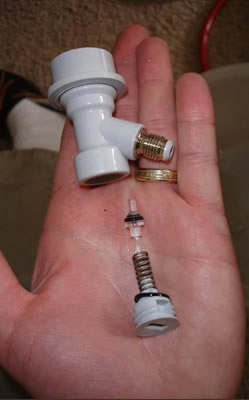CO2 disconnect couplers are no longer only for tank to keg gas lines. Now CO2 filters are on the market, creating a market for high quality quick disconnects. For those utilizing "Jockey Boxes", CO2 disconnect couplers can also come in handy, and can help upgrade your single keg system into a multi-keg system in a snap (literally). These disconnects come in brass, stainless steel, and plastic. Installing these CO2 disconnect couplers is a snap, and here we will go over the tools and techniques for doing so.
 |
| Source: Kegerators.com Archives |
Here is our CO2 gas line tool check list:
- some sharp scissors, clippers, or a utility knife
- hose clamps, preferably of the screw tight variety
- an appropriate screwdriver for the hose clamps you've selected or a pair of needle nose pliers for pressure clamps.
If you are modifying an existing CO2 gas line set-up, you may want to buy an extra length of surgical tubing to help with space issues. The process is quite simple, and the CO2 disconnect couplers on the market today are very much like ball lock units on Cornelius kegs. These couplers are basically compressed air fittings, something that anyone who has worked in any kind of mechanic's shop will recognize instantly.
First, turn off the CO2 gas at the tank and disconnect the CO2 line from any keg it might be attached to. You should now judge whether or not you will need more tubing. Your choice should be based on the purpose for the CO2 disconnect coupler. If you are placing an in-line CO2 filter, for example, then you should take into consideration the rigid length of the unit, and determine if you need a tubing extension. It is always wise to err on the side of more length.
Once you figure this out, you have two ways to go: either you cut your CO2 line in half, and install the couplers in between, or you disconnect one end of your gas line and install the couplers in between that and the new length of tubing you have acquired. Either way, you will then be mounting CO2 lines onto the CO2 disconnect couplers on either side of the middle.
Use the following process:
First, place the hose clamp over the hose you are attaching. Next, force the hose over the hollow nipple on the CO2 disconnect coupler. Once the hose is forced all the way over the nipple, bring up your hose clamp and tighten it enough so that the plastic tubing is slightly bulging out of the slats in the clamp. Do not tighten it too much, or you may compromise the tubing by cutting into it with pressure.
If you are adding a length of gas tubing, simply disconnect the CO2 line that you currently have in service, either at the CO2 regulator or at the keg. Remove the hose clamp from whichever end is easiest to work on. Now repeat the above process to connect your couplers and re-connect your CO2 system.
Easy as pie! Maybe even easier.
Komos
 Summit
Summit
 Beverage-Air
Beverage-Air
 DCS
DCS
 Marvel
Marvel
 Perlick
Perlick
 Bull
Bull
 Avanti
Avanti
 Danby
Danby
 CM Becker
CM Becker
 Continental
Continental
 Fagor
Fagor
 Cal Flame
Cal Flame
 Twin Eagles
Twin Eagles
 Fire Magic
Fire Magic
 GrowlerWerks
GrowlerWerks
 Hestan
Hestan
 Igloo
Igloo
 True
True
 Intertap
Intertap
 Kegco
Kegco
 Keggermeister
Keggermeister
 Koolatron
Koolatron
 KegLand
KegLand
 Krowne
Krowne
 Krups
Krups
 Lynx
Lynx
 Maxx Cold
Maxx Cold
 Micro Matic
Micro Matic
 Midea
Midea
 Nor-Lake
Nor-Lake
 Nostalgia
Nostalgia
 Arctic King
Arctic King
 Synek
Synek
 Taprite
Taprite
 Turbo Air
Turbo Air
 UBC Group
UBC Group
 Value Series
Value Series
 Versonel
Versonel
 VinoTemp
VinoTemp
 New Leaf
New Leaf





